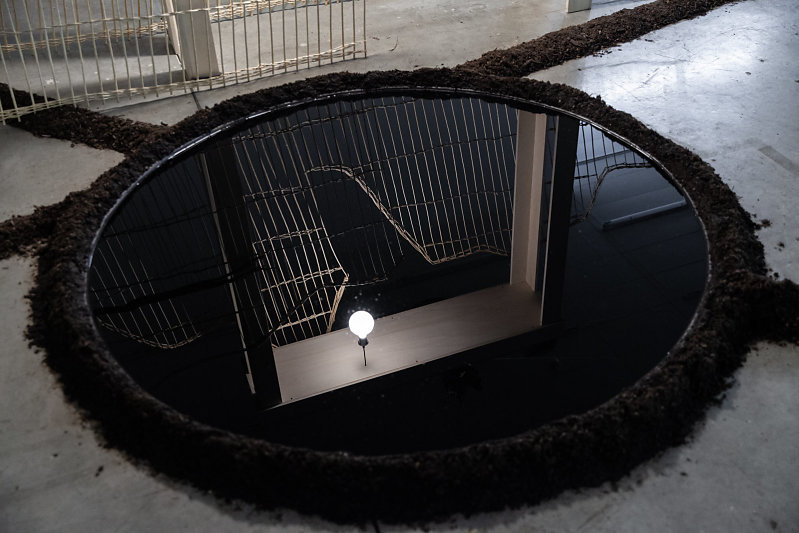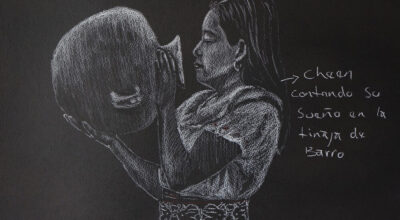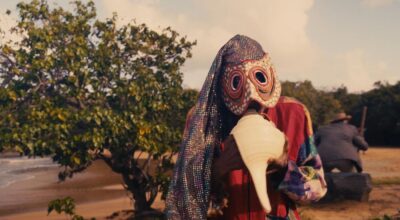
MINIA BIABIANY & ÁLVARO BARRIOS APPROACH COLONIAL ISSUES FROM THEIR CARIBBEAN ANCESTRY
Following up on the exhibition I Remember Earth, the MAGASIN des Horizons (Grenoble, France) continues to explore ecologically engaged art practices. Interweaving poetry and politics, the art center foregrounds the environmental awareness of predominantly female artists. Minia Biabiany’s exhibition approaches the issue of ecology from a non-Western, and more specifically Caribbean, perspective. Thanks to its poetic, ephemeral form, the artist’s work forces us to take a closer look at previously ignored aspects of French colonial history, which is perpetuated through pernicious acts of covert violence. Featured concurrently, an exhibition of Álvaro Barrios’s work brings the discussion to focus on the history of bloodshed in the Caribbean region.


MINIA BIABIANY: J’AI TUÉ LE PAPILLON DANS MON OREILLE / I KILLED THE BUTTERFLY IN MY EAR
Minia Biabiany was born in 1988 in Basse Terre, Guadeloupe, and currently lives and works between Mexico and Guadeloupe. In her practice, she uses the deconstruction of narratives through installations, videos and drawings and build up ephemeral poetics of forms in relation with colonial realities. Her work starts with an investigation on the perception of space and explores the paradigm related to the weaving process and the notion of opacity in visual, oral and written language. She initiated the artistic and pedagogical collective project Semillero Caribe in 2016 in Mexico City and continue to explore the deconstruction of narratives with the body and concepts from Caribbean authors with her experimental pedagogical and experimental platform Doukou.
Her recent exhibition I killed the butterfly in my ear forges a dialog between the exhibition space and a meticulous, immersive installation of objects she fashions in-situ. She constructs her works from scrap materials or those derived from vernacular practices. Here, she invites the visitors to a sound-based corporeal journey toward a beyond—the beyond of her archipelago, the Caribbean.


Minia Biabiany weaves intricate connections between all her installations. The conclusion of one is the beginning of the next, as if she were drawing an “exquisite corpse.” Deliberately organic, her installations combine rallying words and sounds of lambi shells, the repetition of which carries us forward like a refrain. Transported by the wind, these words, images, and sounds lend voice to stories in motion.
In the exhibition, we walk among the forms explored by the artist: earthly patterns, the slightly limp or wounded verticality of the sculptures that she is fond of making: baskets woven by craftsmen that mutate into braids singed by fire (further on, images of banana leaves with Cercospora spots). Again: humus, wax, wood, banana leaves, shells, ash, metal, skeleton, leaf.
Her latest video Toli Toli (2018) uses the spacial metaphor of an old children song to convoke a political and intertwined narrative of the Guadeloupean territory. In the poem-video, the «toli toli» (that means «chrysalid» in créole) shows directions toward an inner elsewhere, toward places and distances shaped by the presence of coloniality. Two hands seem to weave repeatedly with an invisible matter, understanding the technique of the bamboo weaving as the structure of language. Both the song and the bamboo weaving technique (used before to realized fish traps) have almost disappeared of the Guadeloupean culture/knowledge. Minia Biabiany has long been learning weaving techniques (some Mexican, even before she moved to Mexico City, where she now lives). The video -commissioned and coproduced by the Berlin Biennale for Contemporary Art, 2018- ends with the following words: “Butterflies provoke blindness when they blow in your ears.”


I killed the butterfly in my ear thus takes blindness as its starting point. The inability to see brings on the realization that we have lost the knowledge of our own land. This loss is the consequence of long-term policies of assimilation, of the powers in place which support forgetting, and of disconnectedness from our environment.
In her video Pawol sé van, Minia Biabiany subverts the Creole expression, “pawol sé van”—words are wind—and turns it inside out. The story we hear is told in the first person singular in order to reestablish a connection between humans and their environment, the earth.
Minia Biabiany’s exhibition compels us to feel and think differently, to perceive the flow of air, and breathe new life into repressed narratives. Being able to see and think; to think and feel. Feeling and thinking* are the two facets of the methodology adopted by the artist to help us to realize that ecology does not trump decoloniality.
* Sentir-penser avec la Terre: L’écologie au-delà de l’Occident [Feeling-Thinking with the Earth: Ecology beyond the West], Arturo Escobar.

ÁLVARO BARRIOS: EL MAR DE CRISTÓBAL COLÓN
Featured concurrently of the exhibition of Minia Biabiany, the installation of Álvaro Barrios (b. 1945, Barranquilla, Colombia, where he lives and works) brings the discussion to focus on the history of bloodshed in the Caribbean region.
Álvaro Barrios lends the Caribbean Sea a spatial dimension that had been charted and flattened by Westerners. Inked in blue on the front and in bright red on the back, the silkscreen prints El Mar de Cristóbal Colón (Christopher Columbus’s Sea) enlarge the subdivisions that compose the grid of a nautical chart and quantify the slaughter of native peoples and the exploitation of enslaved African population. The cartographic fiction comes undone. The mapmaker’s victorious, dictatorial grid is blown up to bits.
Alvaro Barrios is known for his heterogeneous work, much influenced by Surrealism,, Pop art and Conceptual art. He draws upon the popular culture theme of comic books by including text in his compositions, bold lines and vivid colors. Since the 1970’s, Barrios’ work has been much influenced by the art of Marcel Duchamp. In representing fiction characters in relationship with Duchamp’s objects of modern art, Barrios challenges the imagination and the conscience of the spectator. It is the paradoxical theme and arrangement of his compositions that gives his work a humorous, yet intriguing quality.

MINIA BIABIANY & ÁLVARO BARRIOS
MAGASIN des horizons, Centre National d’arts et de cultures, Site Bouchayer-Viallet, 8 esplanade Andry-Farcy, Grenoble, France
Until July 26th, 2020
También te puede interesar
XXIII BIENAL DE ARTE PAIZ: UNA POSIBILIDAD DE VIDAS EN COMÚN
La XXIII Bienal de Arte Paiz tiene un discurso plural, donde el guion curatorial no se limita a una sola dirección, sino que abarca distintas problemáticas del territorio, el cuerpo, la naturaleza, la identidad...
GIRARNOS HACIA EL CARIBE
A partir de las obras de Carolina Caycedo y Ricardo Cabret que se presentan en la exposición, la historiadora y curadora puertorriqueña Emilia Quiñones Otal argumenta en este texto que el arte que analiza...
NUEVAS ADQUISICIONES DE VIDEO DEL MAC PUERTO RICO
El Museo de Arte Contemporáneo de Puerto Rico (MAC) presenta hasta el 17 de septiembre una serie de videos adquiridos recientemente de los artistas La Vaughn Belle (Tobago, 1974), Michael D. Linares (Puerto Rico,...



